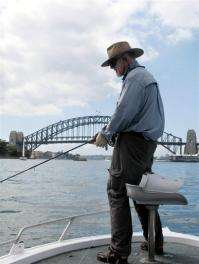Sharks pose Sydney food-chain puzzle

Three shark attacks in Sydney in three weeks drove newspapers and talk show hosts into a feeding frenzy and sent a collective shudder through the other species at the top of the food chain -- humans.
There was fierce debate about why there had been so many attacks -- a total of seven around the country in just three months -- and calls for shark conservation measures to be lifted.
Although all three Sydney victims survived, two of them lost limbs and one of the attacks in particular drew close attention.
As the first light of dawn filters over hills lined with multimillion-dollar mansions and classy seafood restaurants, the surface of the bay shatters into dancing shards of silver.
Flyfishing guide Justin Duggan cuts the motor and lets the small boat drift as a client snakes a line out in search of predators feeding on the tiny skipping fish massed in a suburb of Australia's biggest city.
They are Australian anchovies, near the bottom of a food-chain boom bringing Sydney Harbour roaring back to life, delighting environmentalists and fishermen and making resident fairy penguins fat.
But at the top of the chain are the toothy killers that have been the talk of the town this southern hemisphere summer -- sharks.
On February 11, a navy diver was mauled by a bull shark in Sydney Harbour, not far from the famous Opera House, suffering serious injuries that later forced doctors to amputate an arm and a leg.
While shark attacks are not uncommon off Australia's vast coastline, experts said no one had been bitten by a shark in Sydney Harbour for more than a decade and the last fatal attack was in 1963.
"The harbour is so full of baitfish -- that's why there are so many predators around," says Duggan, a fishing guide for seven years. "It's a protein soup."
Duggan attributes the baitfish boom and the increase in predators -- which themselves attract sharks -- to a ban on commercial fishing in the harbour in 2005 and anti-pollution measures producing cleaner waters.
"Fish like (Australian) salmon and kingfish like cleaner water," he says, pointing out to his client, retired surgeon David Hunt, another pelagic species -- frigate mackerel -- slicing the surface.
"I've seen schooling kingfish under the harbour bridge, and I've certainly seen more sharks this year. We are also just getting reports left, right and centre of people seeing sharks," he said.
Duggan is cautious about the shark scare, however, complaining that hysteria over attacks ignores the fact that people have more chance of being killed in a car while travelling to the beach than they do while swimming.
"It's arrogant to say that sharks should be culled just because of a few attacks on humans -- people have to take their chance when they go into the water," he said.
That attitude was shared by at least one recent shark victim, avid diver and fisherman Brian Guest, 51, who disappeared in a frenzy of fins and blood off a Western Australia beach in December.
Nothing was found of him except shreds from a wetsuit, but a fishing website still carried his words: "I have always had an understanding with my wife that if a shark or ocean accident caused my death then so be it."
Guest also made clear his opposition to the idea that sharks should be killed to reduce the risk to swimmers.
Duggan starts the motor and heads out of the bay, sliding past upmarket suburban homes and under a bridge carrying dense commuter traffic to work.
The surface of the water erupts again just after the bridge, as cormorants, gulls and pelicans herd baitfish into the shallows for a wild feast.
"Look," said Duggan, pointing to four small creatures swimming a little further on. "Those are the fattest fairy penguins I've ever seen."
Sydney's harbour is a vast and beautiful stretch of open water, bays, beaches and islands, lined by some of the most expensive real estate in the world.
It is a great setting for restaurants where residents dine on fresh seafood -- and an unlikely setting for modern humans to face being eaten by prehistoric creatures.
The attack on the diver took place near Garden Island in Wolloomooloo Bay, which hosts a popular strip of expensive eateries and celebrity apartments.
But diners concerned about seafood exacting revenge can take comfort from shark expert John West of Sydney's Taronga Zoo.
"Humans are not part of the shark's diet, otherwise there would be nobody safe in the water," he told AFP.
And even the most feared of predators, the great white shark, doesn't like the taste of humans, an official said in an apparent attempt to reassure swimmers after an attack at Sydney's Bondi Beach in February.
"Note that in almost all cases, great whites tend to release the person after biting -- probably as they don't recognise the taste," said New South Wales Primary Industries Minister Ian Macdonald.
A total of 194 deaths through shark attacks have been recorded in Australia over the past two centuries, leading researchers to point out endlessly that more people die from bee stings and lightning strikes.
But there is something about being eaten that resonates with humans -- and gave pause to diners at Wooloomooloo, at least for a few weeks this summer.
(c) 2009 AFP















